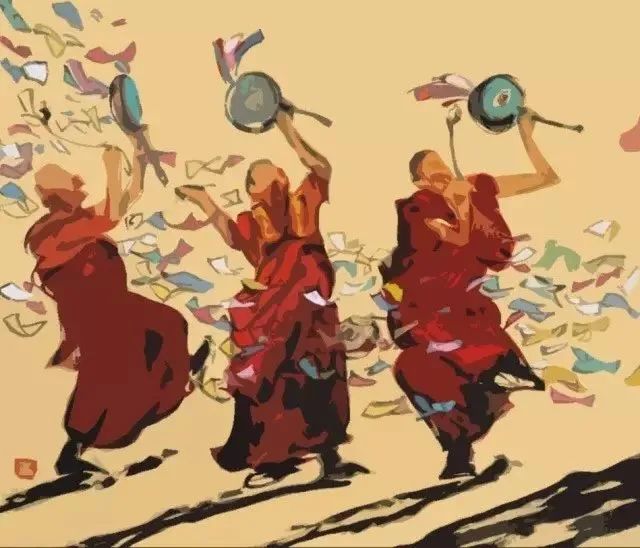Great fullness | seven treasures open the treasure in your heart -—— Sad wish ▼ endless ——— Dozhikhin renzeng danbinima Rinpoche, the only incarnation, will continue to benefit all sentient beings by clicking the ↑ link and clicking the audio above to play Tibetan Buddhism.

There are many kinds of magic tools.
According to different inheritance and Dharma pulse, the magic tools needed in the process of cultivation are also different, Today, let’s take a look at the three most commonly used magic tools in Tibetan Buddhism.
Vajra bell is a common tool in chanting sutras, practicing Dharma and Buddhist music in Tibetan Buddhist dharma activities.
It is one of the Dharma tools of Esoteric Buddhism and is also called golden bell.
The diamond bell represents the goodness, convenience and compassion of the Buddha.
It is a bell that is vibrated to urge all sentient beings to improve and arouse the surprise of the Buddha and Bodhisattva.
The characteristic of the Dharma Realm is to awaken all sentient beings sleeping in ignorance.
At the same time, accomplished practitioners benefit the majority of mindless beings with a powerful centrifugal force and through the sound of bells and pestles.
It also has the meaning of “awakener”.
The bell can wake sentient beings up in their blind sleep.
Sentient beings are constantly reincarnated due to ignorance and persistence.
The three poisons of greed, anger and madness are born from right, so they use the bell to be alert.
The whole body of diamond bell is generally cast with copper, with different specifications.
The common general height is about 20cm.
The shape of the bell body is like a clock, the lower mouth is round, and the decorative patterns on the top and the bell body.
The bell body is hung with a copper tongue.
When playing, hold the bell handle in your left hand and swing the bell mouth downward.
The tone is beautiful and pleasant, and the sound is far away.
Vajra pestle Vajra pestle, also known as Vajra, also known as treasure pestle and demon subduing pestle, was originally a weapon in ancient India.
The word Vajra pestle was originally an electro-optic title of emperor Shi.
It is called Vajra pestle because it is strong and can break all kinds of materials.
According to Da Zang Mi Yao, Vajra pestle is the spiritual meaning of Bodhi, which can “break the two sides of the middle path.
There are 16 Bodhisattvas in it, which also shows that the 16 emptiness is the middle path, and there are five strands on both sides.
Five Buddhas and five wisdom meanings also show that ten paramita can destroy ten kinds of troubles”.
In Buddhism Esoteric Buddhism, Vajra pestle symbolizes invincible and invincible wisdom and true Buddha nature.
It can break all kinds of troubles and destroy all kinds of obstacles.
It is the holding object of all Buddhists in esoteric Buddhism or the magic weapon of yogis.
Tantric practitioners often carry this pestle to symbolize the wisdom of the Tathagata Vajra, which is used to break the demons inside and outside the path.
In Buddhist rituals, Vajra pestle and Vajra bell are often used together.
They are equally important in Vajrayana.
Generally, the left hand holds the bell and the right hand holds the pestle.
Pestle represents masculinity and symbolizes Buddha’s perfection; The bell represents Yin, which directly reflects the emptiness and wisdom of Buddha.
Dharma Drum Dharma Drum is one of the praising instruments in Tibetan Buddhism.
There are many kinds, as shown in the figure below.
It is mainly used in Buddhist celebrations, religious festivals, the ceremony of sitting on the bed and opening the light of living Buddha and other major festive religious activities.
The drum hammer of the crank drum is curved, like a bow, and the drum surface is about 1m in diameter.
At ordinary times, we often see this type of drum, which is called “broken Dharma Drum”, which is one of the indispensable Dharma tools for monks and yogis to practice broken Dharma.
The Dharma Drum symbolizes the truth of reality.
Its sound is the combination of convenience and wisdom, which can free people from the pain of reincarnation.
There are many kinds of broken Dharma drums.
When making some drums, scriptures will be placed in the drums to give them special Buddhist dharma meaning.
These three kinds of magic instruments are common in Tibetan Buddhism.
It is not difficult to learn and use the skills.
As long as you practice and master the know-how, you can use them freely.
Whether in a large Dharma meeting or in the process of practicing alone, shaking the tambourine and singing beautifully are the best companions on the road of practice.
Source: [I Dunzhu blood cultivation society] I will never leave the teacher for generations Always enjoy the music of victory, and the perfect and authentic merit has been achieved Only wish to get hold of Vajra quickly -—— Failed Bodhi fruit • Make friends first ——— ▼ click “↑ above” to enter daruxiangtang micro store ☼ ☽ delay stretch Read Read ▼ the brief biography of the fourth dozhiqin renzeng danbinima Rinpoche.
The fourth dozhiqin renzeng danbinima Rinpoche has integrated into the Dharma world.
The fifth dozhiqin renzeng jimedojavasan Rinpoche is the only incarnation of the dozhiqin Dharma king.
He will continue to benefit all sentient beings.
Guru Dali, the spiritual bone left by the fourth dozhiqin Dharma King, personally runs the fourth dozhiqin Dharma Wang Yuanji law society states that the pictures and texts come from the Internet.
If there is any infringement, please contact and delete them in time..

